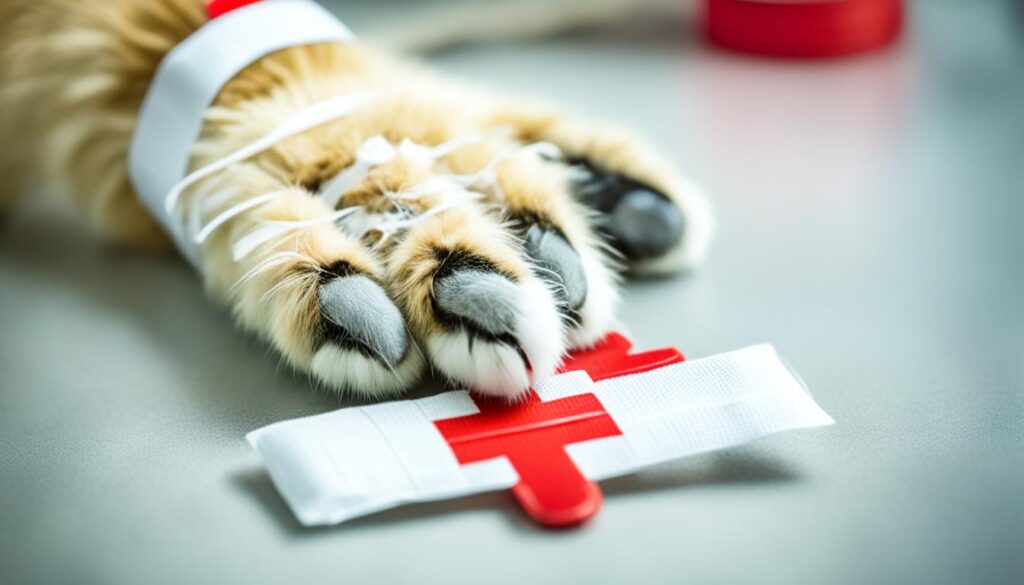Welcome to the world of pet health. We’re here to beat the big problem of overweight pets. This issue is big in America, not just with people but our furry pals too. About 56% of dogs and 60% of cats in the U.S. have some extra weight.1 Hold your horses, because 30% of them are now part of the heavy club!1 We’ll show you how to help your pets shed those extra pounds and find a path to a healthier, happier life. So, grab a treat (low-cal, naturally) and let’s get started.
Key Takeaways
- The alarming rise of pet obesity in the U.S., with 56% of dogs and 60% of cats considered overweight
- Approximately 30% of pets are clinically obese
- Overweight pets face a range of health issues, from arthritis to chronic kidney disease
- Proper diet and exercise are crucial for maintaining a healthy weight and lifespan for pets
- Understanding pet food labels and selecting premium pet food options can support your pet’s wellness
Understanding the Alarming Rise of Pet Obesity
A pudgy puppy can look cute, but it’s risky. Too many treats can lead to extra weight. Dogs become overweight if they add 10%-30% to their ideal body weight.2 Above 30%, it’s obesity. Cats face the same issue.3 Pet obesity brings a host of health problems, from arthritis to kidney disease.
Defining Pet Obesity and Its Health Consequences
Imagine diseases like bladder problems, liver issues, and low thyroid levels.2 It’s a pet health bingo; we don’t want to fill the card. Let’s discuss this serious issue and help our pets become lighter and healthier.
The Startling Statistics of Overweight Pets
2 Surprisingly, 51% of dogs, 44% of cats, and 29% of small mammals are too heavy.2 All 100% of vets worry about pet obesity, but2 68% of pet owners think their pets are just right. Also, 67% don’t see obesity as a concern.2 In the UK, almost 8.5 million pets are overweight. This figure grew by nearly 600,000 in five years.2 Overweight pets risk living two years less than healthier ones.2
The Impact of Diet on Pet Health
Imagine this: dogs usually live 10-13 years, cats extend that to 12-18, and horses triumph with 25-30. But there’s a troubling issue we must talk about— obesity. It cuts short the time we have with our animal friends.4
Obesity’s Effects on a Pet’s Lifespan
A study on Labrador retrievers shook things up. It showed that being a bit overweight can steal almost two years from your dog. This is compared to dogs in better shape.4 Take the tiny Yorkshire Terrier for example. A healthy male of this breed can live around 16.2 years. But with some extra weight, this could drop to 13.7 years. That’s a big difference of 2.5 years. We don’t want our terriers to lose this time!
Common Health Issues Linked to Obesity
Obesity isn’t just about looks. It brings serious health problems. Diabetes can make life tough. Heart disease and high cholesterol levels are risks. And arthritis can make movement painful.4 Changing to a better diet is not a trend, it could be their saving grace. Time to start offering our pets a healthier, longer future.

Identifying Common Culprits to Pet Obesity
Let’s look into why our pets might be carrying some extra weight. Those cute treats could be the problem. They look innocent but might be making your pet gain weight.5
Overfeeding and Lack of Portion Control
Finding the right meal size for your pet is critical. It’s like a custom suit. It’s based on their food type, how often they eat, weight, desired weight, metabolism, and how much they exercise.
High-Calorie Treats and Table Scraps
Feeding your dog scraps might be hard to resist. But, it adds to their calories and can make them too heavy. Some human food ingredients can also be bad for them. So, not sharing your food is best for their health.5
Insufficient Exercise and Sedentary Lifestyles
Dogs need daily walks, maybe 20-30 minutes, but sometimes more. These walks are vital for a healthy weight. It’s more than just going out; it keeps them fit.5
Low-grade pet food is not always good. It contains fillers, chemicals, and artificial preservatives. This can lead to stomach issues and poor health.
Prevent Pet Obesity by Choosing the Right Food
In an ideal world, pets would get equal food options. But, the real world has an overwhelming variety. It’s not easy to find the perfect, healthy, and budget-friendly food for your pet. It’s like trying to teach your dog a new trick.
Not all dogs should eat the same food. Different life stages and breeds have unique nutritional needs. Puppies should eat differently than adult dogs. And big dogs have different needs than small ones. Use The Merck Veterinary Manual as your guide for the best nutrition.
Decoding Pet Food Labels and Ingredients
Let’s make sense of food labels. The FDA lists eight important pieces of info, including names and guidelines. But, understanding ingredient quality is not always clear. This might lead to feeding your pet food that isn’t great. It can be confusing!7
Pet Evolution’s Premium Pet Food Offerings
Pet Evolution wants pet owners to choose healthy food. We focus on providing the best for your pets. Our food is tailored to various needs and adds great taste. Here are the types of food we offer:
- Select Foods: Free of harmful ingredients. Perfect for starting fresh with your pet’s diet.
- Classic Foods: It includes Select Foods benefits but with more proteins and the chance to enjoy fruits and veggies. Because your pet deserves the best.
- Signature Foods: This type offers the quality of raw or freeze-dried food in a rich, nutritious meal. It’s top-tier for your pet.
We at Pet Evolution aim to guide pet owners in making the best food choices. Our premium offerings support various dietary needs. This ensures your pet loves their food and stays healthy.
https://www.youtube.com/watch?v=c78KgiPOJIQ
Tips for Transitioning Your Pet to a Healthier Diet
So, you’re ready to switch your pet’s food for the better. But, we don’t advise doing it all at once. That would be like going from 0 to 100 in a second. Today is a great day to start this exciting journey for your furry friend. Follow our seven-day plan to make it a smooth change for their taste and belly.
Start with 25% new food and 75% old food for days one and two. This is a gentle way to begin the change in meals.1
From days three to five, make it an even mix, 50% new food and 50% old food. Your pet will start to enjoy the new flavors without feeling overwhelmed.1
On days six and seven, move to 75% new food and 25% old food. This is a slow but sure way to get them used to their new diet.1 By day eight, they should happily be eating their new, healthier meals.
What about the old food you have left over? You can be a pet hero by giving it to a shelter. Shelters always appreciate more food to care for their animals.
The dangers of your pet being overweight are serious, and bad food can contribute. You are in charge of keeping your pet healthy and happy. A good diet, the right amount of food, and regular play keep them in the best shape.
Feeling lost about what food to choose or how much to feed? Visit your local Pet Evolution pet shop for expert advice. Their team is eager to help you keep your pet well-fed and joyful.

Pet Health and Wellness Tips
Dogs need a good 20-30 minute walk daily, and maybe more, depending on size and breed.8 These walks are about more than just going to the bathroom. They keep your furry friend in shape! Plus, looking after their coat and skin with regular grooming helps keep them healthy.9
Incorporating Regular Exercise Routines
Dogs should get 30 minutes to two hours of exercise each day. Cats need play sessions of 10 to 15 minutes, two to three times a day.8 By making these activities part of their daily life, you set them up for a long, happy, and healthy time with you.
Grooming Habits for a Healthy Coat and Skin
Grooming is good for more than just looks. It helps spot skin problems or pests like ticks and fleas.9 Keeping your pets at a healthy weight also fights off diseases and keeps them moving well.9
Veterinary Care and Preventive Measures
Getting your pet’s teeth checked regularly is as important as yours.9 Preventing parasites all year round stops dangerous illnesses. Getting their shots not only saves their life but others’ too, by keeping diseases away.9 Spaying and neutering has many health benefits and stops more animals from needing homes.9 Optimum Wellness Plans® provide easy ways to keep your pet healthy, from their first shots through their whole life.9
Training Techniques to Promote Mental Stimulation
Training your pet is more than just teaching tricks. It’s key for their happiness. You can keep your pet’s mind active with fun activities. This includes playing with puzzle toys and teaching them new tasks.10 Positive rewards make this learning enjoyable for them too.10
Get interactive toys for your pet that challenge them. Toys that give treats or need puzzle-solving are great.10 Teaching them new things is not only educational but also fun.10 You can make mealtime exciting by using food puzzles.
Changing up your pet’s toys regularly is also helpful. It stops them from getting bored. Try to keep things fresh by giving them new toys sometimes.10 Play games like hide and seek to keep them sharp. This uses their natural skills and keeps their brain active.
Letting pets explore new places is good for their minds. It keeps them inquisitive and excited.10 Obedience classes or meeting up with other pets are great for their social and mental well-being. Plus, teaching them new things with clicker training is a fun mental exercise.10
Challenge your pet’s brain with games and new tricks. This keeps them alert. Regular play and exercise are also very important. This could be through games, walks, or agility courses.10 Mix up their daily activities to keep their interest and mind engaged.10

Addressing Behavioral Issues through Positive Reinforcement
Dealing with your pet’s behavior is important for their well-being and your home’s peace. By using positive reinforcement, you can change bad habits and encourage good ones.11 This method involves rewarding good actions. It builds a stronger bond with your pet.11 With the right steps, patience, and consistency, you can help your pet become a well-loved friend.11
In the Western Veterinary Center, there’s been a 20% rise in using this method in the last year.11 Pet owners share a better connection with their pets 90% of the time after this training.11 Bad behaviors in pets dropped by 30% with regular use of positive reinforcement.11 Furthermore, 85% saw less anxiety in their pets, and 70% noticed less aggression with this approach.11 Giving a treat right after a good action led to success 95% of the time in training.11
No laws require lab animals to be trained for cooperation voluntarily. Yet, methods such as operant conditioning are used to make them work with people.12 Such training improves the animals’ lives by reducing their stress and may lower the number used for research.12 While the main focus is on primates, pigs, cats, and others also get trained for health care reasons.12 This method involves giving rewards half a second after a desired action.12
Starting training early with positive reinforcement prevents most behavior problems.13 Remember, about 70% of sudden changes in pet behavior are due to health issues.13 If your pet’s behavior is complex, over 60% of owners get help from experts.13
Positive reinforcement can help a lot. It makes training more effective, strengthens the bond with your pet, and keeps your home peaceful. Take your time, be consistent, and you will see great results. Your furry friend will bring you joy and trust for many years.
Emergency Preparedness: Pet First Aid and Insurance
Emergencies with pets can catch us off guard. So, it’s vital to be ready. Knowing the basics of pet first aid is a great first step. This includes treating wounds, doing CPR, and spotting when your pet’s in trouble.14 Around 80% of pets end up needing an emergency vet visit. These visits can be very costly, ranging from $800 to $1,500.14 The first check-up alone can cost $150 to $250. Costs vary by where you live, the tests and treatments needed, and if you have pet insurance or not.14
Getting pet insurance is one way to plan ahead. It can help cover the bills if your pet gets hurt or sick. Only about 2% of pet owners have this kind of insurance.15 By being prepared, you’re looking out for your pet’s health in advance.
14 It’s smart to have important info, like your vet’s number and your pet’s records, ready in a first aid kit. ASPCA’s Animal Poison Control Center is always there for poison emergencies, at 888-426-4435.14 In urgent situations, remember to stay cool and check your pet carefully. Try to keep them calm too, with a gentle voice and slow approach.14 In some cases, an unexpected surgery might cost pet owners up to $10,000.14
15 Lots of pet owners keep a close eye on their pet’s health. They make lists of allergies and meds, and look up nearby animal hospitals for emergencies.15 Many also prepare an emergency kit for their pets. This kit has essentials and comfort items. Plus, they make a plan for how to move their pet safely during a crisis.15 They also keep an updated list of important phone numbers, including their vet’s, ready for quick calls in an emergency.15 Most pet owners stay on top of their pet’s health with regular check-ups. They also make sure their vet always has their latest contact info, which can be a lifesaver in an emergency.15

Maximizing Your Pet’s Dental Health
Keeping your pet’s teeth and gums healthy is a big part of their overall health. Brushing their teeth every day is key to preventing cavities and gum disease16. Use toothbrushes and toothpaste made just for pets to keep them safe and healthy16.
Treats and chew toys can help keep teeth clean and reduce plaque. Make sure your pet sees the dentist regularly. You can save money by finding deals and having good pet insurance16.
Adding water supplements and using rinses can also help. These reduce plaque and bad breath. A balanced diet is important too, choosing chewy food over sugary snacks16.

For almost 20 years, vets have done thousands of procedures on pets under anesthesia17. They take special x-rays that show clear images of each tooth. These x-rays are free with a dental cleaning to check for hidden issues17.
Many older pets can have anesthesia without problems17. After the x-rays, the vet gives the teeth a score from 1 to 4. Depending on the score, the pet may need deep cleaning under anesthesia17.
While under, vets closely watch the pet’s vitals to keep them safe17. A dental cleaning for your pet is a major surgery. It’s not just a check-up17.
Dogs can get plaque too, which turns into tartar. This can cause serious dental issues. Regular dental care is as important as good food and exercise for their health18.
Brushing your dog’s teeth is the best way to keep their mouth healthy. You should try to brush their teeth every day18.
Regular check-ups at the vet are key for a dog’s dental health18. Giving your dog chews can also help. Dogs may need more dental cleanings as they get older, especially if they show signs of gum disease18.
Dental cleanings for dogs happen under anesthesia. They include cleaning and checking for dental issues18. Your vet will tell you how often your dog needs it, depending on their dental health18. In severe cases, a dog might need teeth removed or see a specialist18.
Conclusion
In conclusion, reaching the peak of19 pet health involves many factors. These include good food, exercise, keeping the mind sharp, and regular health checks. Tackling pet obesity19 and knowing how food affects them is crucial. So is being aware of what’s harmful to pets.
Teaching pets well with effective methods, encouraging good habits, and being ready for emergencies and taking care of teeth are key. With these, we can ensure our pets not only survive but thrive, giving us joy for a long time.
It’s on us to keep our pets healthy and happy. With the right info and tools, we can bring them their best life19. These top-notch suggestions will set you on a path full of joy and love with your pet.
FAQ
What is the prevalence of pet obesity in the United States?
What are the health consequences of pet obesity?
How does pet obesity impact a pet’s lifespan?
What are the common causes of pet obesity?
How can I transition my pet to a healthier diet?
What are some essential pet health and wellness tips?
How can I prepare for pet emergencies?
Source Links
- https://www.petevolution.com/blog/how-to-transition-your-pet-to-a-healthier-diet-tips-and-tricks/
- https://www.ukpetfood.org/resource/new-report-reveals-rise-in-pet-obesity-and-heightened-veterinary-concern.html
- https://pinecreekah.com/blog/keeping-your-furry-friends-fit-a-guide-to-preventing-pet-obesity/
- https://www.ncbi.nlm.nih.gov/pmc/articles/PMC7329990/
- https://hollandlakevet.com/lets-get-physical-4-tips-for-managing-your-pets-weight
- https://www.petevolution.com/blog/how-to-transition-your-pet-to-a-healthier-diet-tips-and-tricks
- https://www.petobesityprevention.org/weight-loss-dogs
- https://collegehillsvet.com/10-proven-ways-to-keep-your-pet-healthy/
- https://www.banfield.com/Bblog/bwell/2023/6-tips-for-Pet-Wellness-Month
- https://vetcbdhemp.com/elevate-your-pets-wellness-exploring-the-benefits-of-mental-stimulation-games/
- https://www.wvcvet.com/blog/the-power-of-positive-reinforcement-training-your-pet-with-kindness
- https://www.ncbi.nlm.nih.gov/books/NBK500422
- https://faithfulfriendsvetclinic.com/pet-behavior-problems-common-causes-and-solutions
- https://www.carecredit.com/well-u/pet-care/dos-and-donts-for-dealing-with-pet-emergency/
- https://www.apah24.com/be-ready-for-anything-with-these-pet-emergency-preparedness-tips/
- https://petwellnessdirect.com/blogs/news/affordable-pet-oral-care-top-dental-hygiene-tips-tocs
- https://healthypetvetclinic.com/dental-health/faq-about-your-pet-s-dental-health.html
- https://www.thesprucepets.com/dental-care-for-your-dog-1117857
- https://eugeneanimalhospital.net/keeping-your-pet-mentally-and-physically-fit/
